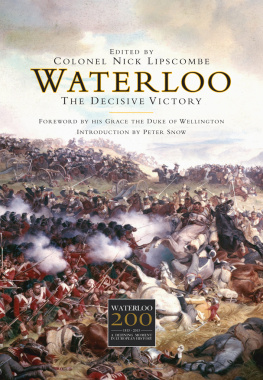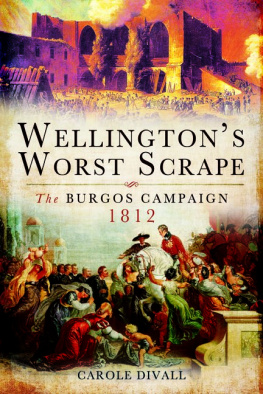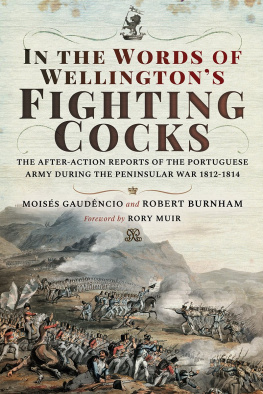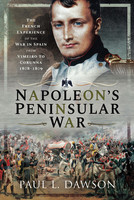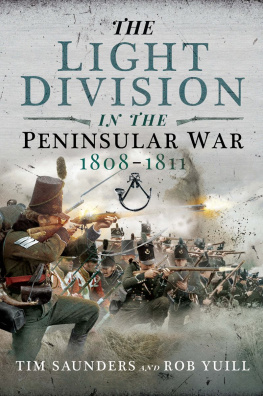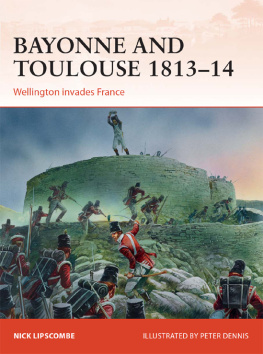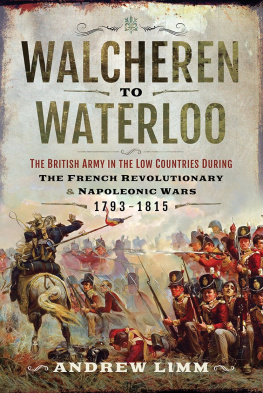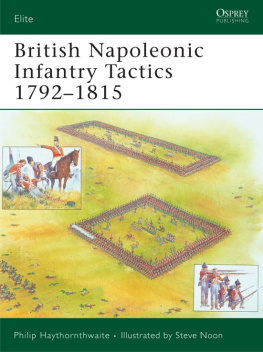Wellingtons Eastern FrontTo Ina, with all my love, you are my light
Wellingtons Eastern Front
The Campaigns on the East Coast of Spain 18101814
Nick Lipscombe
First published in Great Britain in 2016 by
PEN AND SWORD MILITARY
an imprint of
Pen and Sword Books Ltd
47 Church Street
Barnsley
South Yorkshire S70 2AS
Copyright Nick Lipscombe, 2016
ISBN 978 1 47385 071 2
eISBN 978 1 47385 072 9
Mobi ISBN 978 1 47385 073 6
The right of Nick Lipscombe to be identified as the author of this work has been asserted by him in accordance with the Copyright, Designs and Patents Act 1988.
A CIP record for this book is available from the British Library.
All rights reserved. No part of this book may be reproduced or transmitted in any form or by any means, electronic or mechanical including photocopying, recording or by any information storage and retrieval system, without permission from the Publisher in writing.
Pen & Sword Books Ltd incorporates the imprints of Archaeology, Atlas, Aviation, Battleground, Discovery, Family History, History, Maritime, Military, Naval, Politics, Railways, Select, Social History, Transport, True Crime, Claymore Press, Frontline Books, Leo Cooper, Praetorian Press, Remember When, Seaforth Publishing and Wharncliffe.
For a complete list of Pen and Sword titles please contact
Pen and Sword Books Limited
47 Church Street, Barnsley, South Yorkshire, S70 2AS, England
E-mail:
Website: www.pen-and-sword.co.uk
List of Illustrations
Colour Plates (between pages 50 and 51)
1. General Sir John Murray playing chess with Ellen Adderley (his god-daughter). A painting by Pieter Christophel Wonder (17801852).
2. The town and castle of Biar, in Valencia. Colour aquatint published by James Daniell, 1814. Artist Lieutenant Colonel Reeves. By kind permission of the Anne S. K. Brown Military Collection, Brown University Library.
3. The battle at Castalla. Colour aquatint published by James Daniell, 1814. Artist Lieutenant Colonel Reeves. By kind permission of the Anne S. K. Brown Military Collection, Brown University Library.
Black and White Plates (between pages 114 and 115)
1. Marshal Louis-Gabriel Suchet. Colour aquatint published by Aubry-Lecomte, 1815. Artist Hyacinthe-Louis-Victor-Jean-Baptiste. By kind permission of the Anne S. K. Brown Military Collection, Brown University Library.
2. General Pierre-Joseph Habert. Authors collection.
3. General Jean-Isidore Harispe. By kind permission of the Muse Basque, Bayonne.
4. General Sylvain-Charles Vale. Authors collection.
5. Marshal Etienne-Jacques-Joseph-Alexandre Macdonald, Duke of Taranto. Authors collection.
6. General-Charles-Mathieu-Isidore Decaen, commander of the French Army of Catalonia, 18121813. Authors collection.
7. Baron Jzef Grzegorz Chopicki. Authors collection.
8. Rear Admiral Benjamin Hallowell RN. Authors collection.
9. Lieutenant General Lord William Henry Cavendish-Bentinck. Authors collection.
10. Admiral Edward Pellew, 1st Viscount Exmouth. Mezzotint published by C. Turner, 1818. Artist William Beechey. By kind permission of the Anne S. K. Brown Military Collection, Brown University Library.
11. Lieutenant General Sir Thomas Maitland. Mezzotint published by Lupton, 1805. Artist John Hoppner. By kind permission of the Anne S. K. Brown Military Collection, Brown University Library.
12. Rear Admiral Sir Edward Codrington RN. Lithograph published by Thomas Collins, c.1840. Produced by Maclure, Macdonald & Macgregor. By kind permission of the Anne S. K. Brown Military Collection, Brown University Library.
13. Major General Samuel Ford (Samford) Whittingham. Authors collection.
14. General Joaqun Blake y Joyes. By kind permission of Jos Luis Arcn Domnguez.
15. General Francisco de Paula Mara Baso Copons y Navia. Authors collection.
16. General Diego de Caas y Portocarrero, Duque del Parque. By kind permission of Jos Luis Arcn Domnguez.
17. General Joseph (Jos) ODonnell. Authors collection.
18. Barcelona Bay. Authors collection.
19. The combat at Castalla, 21 July 1812. Original painting by Jean-Charles Langlois, chteaux de Versailles et de Trianon. This is a copy which hangs in the Town Hall in Castalla and is reproduced here by the kind permission of the Alcalde.
20. A photograph of the battlefield at Sagunto. Authors collection.
21. A photograph of the pass at Biar. Authors collection.
22. A photograph of the battlefield at Castalla. Authors collection.
23. Fort Trinity overlooking the Bay at Rosas, which the audacious Captain Cochrane RN tuned into a vast mantrap. Authors collection.
List of Maps
1. The east coast theatre of operations, 18101813
2. The Iberian Peninsula French axes of advance 1810
3. French encirclement of the city of Valencia, December 1811
4. Spanish approach routes, 20 July 1812
5. Cartagena, 1812
6. Alicante, 1808
7. Alicante, 1812
8. French advance 10 13 April 1813
9. Suchets retreat from Valencia, June 2013
10. Operations in Catalonia, JulySeptember 1813
11. Combat at Ordal, 13 September 1813
Colour Maps (in colour plate section):
1. The French siege of Tortosa, 16 December 1810 2 January 1811.
2. The French siege of Tarragona, 4 May 30 June 1811.
3. The French siege of Sagunto, 23 September 26 October 1811.
4. The battle of Sagunto, 25 October 1811.
5. The battle of Castalla, 13 April 1813.
6. The Allied siege of Tarragona, 312 June 1813.
Preface and Acknowledgements
During a recent battlefield study for the staff of the British Armys headquarters, the accompanying academic provided the group with a strategic and operational setting to the situation at the end of 1811 and the start of 1812, which set the conditions for Wellingtons strike at Ciudad Rodrigo and for the commencement of his 1812 campaign. The academic in question, who has an excellent grasp of the Peninsular War, did not make the connection that it was the movement of vast numbers of French soldiers to support the campaign on the east coast of Spain that presented Wellington with his vital opportunity. This oversight is symptomatic of a wider failing in many modern histories of the war, which skirt over the campaigns on the east coast or (increasingly) ignore them altogether. Juxtaposed against Wellingtons glorious victories in Iberia it is inevitable that the less celebrated achievements and failures of questionable generals, would be ignored or mentioned merely to denigrate one in order to elevate the other. Quite simply, however, Wellingtons wider achievements cannot be understood without recognising the whole war and where that war fitted into the wider Napoleonic struggle.


